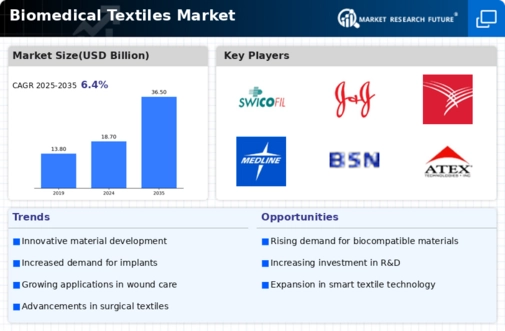Top Industry Leaders in the Biomedical Textiles Market
 Biomedical textiles, the intricate tapestry where medicine and textiles intertwine, weave a dynamic and competitive market landscape. Navigating its threads requires dissecting the strategies employed by key players, the factors influencing market share, the echoes of recent developments, and the overall pulse of this rapidly evolving field.
Biomedical textiles, the intricate tapestry where medicine and textiles intertwine, weave a dynamic and competitive market landscape. Navigating its threads requires dissecting the strategies employed by key players, the factors influencing market share, the echoes of recent developments, and the overall pulse of this rapidly evolving field.
Strategies Stitching Success:
-
Product Diversification: Leading players like Johnson & Johnson, Medtronic, and Stryker are expanding their portfolios beyond traditional offerings (surgical sutures, wound dressings) to cater to niche applications. This includes regenerative scaffolds, implantable meshes, and smart textiles with therapeutic functionalities, ensuring a foothold in lucrative segments.
-
Geographical Stitches: Asia-Pacific, with its large patient population and rising healthcare expenditure, is a fertile ground for expansion. Companies are establishing local production facilities, forging regional partnerships, and tailoring product offerings to specific healthcare needs, solidifying their presence in this high-growth zone.
-
Innovation Threads: Continuous research and development are crucial for staying ahead. Companies like Baxter International and 3M are investing heavily in biocompatible materials, advanced manufacturing techniques, and integration of electronics into textiles, pushing the boundaries of what these materials can achieve.
-
Vertical Integration: Some players are integrating upstream (fiber production) and downstream (finished medical device manufacturing) activities. This enhances control over supply chains, optimizes costs, and provides a competitive edge by offering complete solutions.
-
M&A Merges: Mergers and acquisitions play a role in market consolidation. For instance, Medtronic's acquisition of Covidien in 2015 strengthened its position in the cardiovascular biomedical textiles market.
Factors Shaping the Market's Fabric:
-
Demand Drivers: The aging population, increasing prevalence of chronic diseases, and advancements in minimally invasive surgeries fuel the demand for biomedical textiles. These materials offer faster healing times, improved patient outcomes, and reduced healthcare costs.
-
Regulatory Stitches: Stringent regulations, particularly in Europe and North America, govern biocompatibility, sterility, and safety of biomedical textiles. Companies must navigate these complex regulations to ensure market access and compliance.
-
Cost Constraints: High initial investment in research and development, coupled with stringent regulatory requirements, can pose challenges for market entry and scalability, particularly for smaller players.
-
Sustainability Concerns: Environmental consciousness is driving the demand for bio-based and biodegradable biomedical textiles. Companies are exploring sustainable materials and closed-loop manufacturing processes to reduce their environmental footprint.
Key Players
Some of the prominent players in the global biomedical textiles market are Secant Group, LLC (U.S.), Confluent Medical Technologies (U.S.), SWICOFIL AG (Switzerland), Johnson & Johnson Services, Inc. (U.S.), Meister & Cie AG (Switzerland), Cardinal Health. (U.S.), Smith & Nephew (UK), Medline Industries, Inc (India), Integra LifeSciences Corporation. (U.S.), PAUL HARTMANN AG (Germany), BSN medical. (Germany), B. Braun Melsungen AG (Germany), 3M (U.S.), Elkem Silicones (Norway), and ATEX TECHNOLOGIES (U.S.).
Recent Developments:
-
August 2023: A class-action lawsuit is filed against a major manufacturer of surgical sutures for alleged material flaws and adverse patient outcomes, highlighting the potential for legal challenges in this growing market. -
July 2023: A group of industry players and environmental organizations launch a collaborative initiative to develop sustainable end-of-life solutions for used biomedical textiles, promoting a circular economy in the industry. -
June 2023: The first clinical trial of a bioabsorbable cardiac patch made from natural silk protein shows promising results, paving the way for innovative regenerative therapies. -
May 2023: Researchers successfully integrate microfluidic channels into biomedical textiles, enabling on-demand drug delivery and real-time monitoring of wound healing, pushing the boundaries of smart textiles functionalities.









